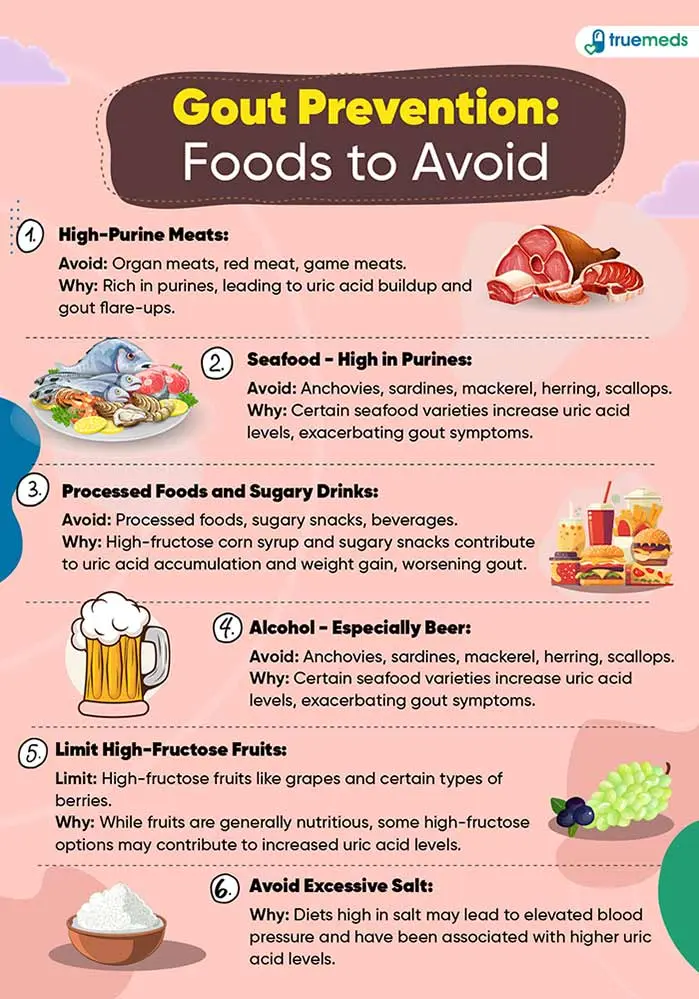Gout Diet Guide to Treat Uric Acid: Foods to Eat & Uric Acid Foods to Avoid
Last updated on : 20 Jun, 2024
Read time : 11 min
Introduction
If you’re dealing with gout or aiming to prevent it, understanding what to eat and what uric acid foods to avoid is key. This comprehensive blog will unravel the mysteries of a gout-friendly diet, offering insights into the best food choices and the ones to steer clear of. From delicious meal plans to practical tips, embark on a journey towards better management of gout and improved overall well-being. Get ready to take charge of your diet and embrace a lifestyle that supports your health goals. Let’s dive in and explore the ultimate strategies for a gout diet that works for you!
What is Gout?
Gout is like a grumpy guest that sometimes visits our body, causing pain and discomfort. It happens when tiny crystals made of uric acid decide to throw a party in our joints. Now, uric acid is a normal thing in our bodies, but when there’s too much of it, these crystals form and create trouble.
Imagine these crystals as tiny troublemakers, and the joints they pick for their party become swollen, red, and super painful. Most times, they love hanging out in the big toe, but they can also crash parties in other joints.
Now, where does this uric acid come from? It results from our bodies breaking down substances called purines, found in some foods and drinks. So, what’s the plan to deal with these uninvited crystal guests? Well, it involves making friends with a gout-friendly diet, staying hydrated, and sometimes, taking medication.
The key is to keep these uric acid levels in check so the crystals don’t decide to throw another party. Gout might sound like an unwelcome visitor, but with the proper steps, we can show it the exit and keep our joints happy and pain-free.
How Does Food Affect Gout?
Imagine your body as a busy city, and food is like the traffic that moves through it. Now, in the case of gout, certain foods can be a bit like mischievous troublemakers causing traffic jams, or in this case, uric acid buildup.
When we eat, our bodies break down substances called purines, which are found in some foods. These purines, if not managed well, can turn into uric acid. Now, uric acid is like an average citizen in our city, but if there’s too much of it, trouble starts.
Some foods are the culprits that contribute to higher uric acid levels. High-purine foods, such as red meat, seafood, organ meats, and certain drinks like sugary beverages and alcohol, can be the troublemakers in this scenario. They add to the uric acid traffic, leading to congestion in the joints.
On the other hand, there are friendly foods that help manage uric acid levels. Cherries, for example, are like traffic controllers, helping to regulate the flow of uric acid. Low-fat dairy, fruits, vegetables, and whole grains are also like the smooth traffic that keeps things moving without causing chaos.
So, managing gout involves being mindful of our food choices. It’s like directing the traffic in our city to avoid congestion and keep the uric acid levels in check. By understanding how food affects gout, we can make intelligent choices that help prevent those painful traffic jams in our joints.
Uric Acid Foods to Avoid: Guide to Prevent Gout
When it comes to managing gout, avoiding certain foods can make a significant difference. Below are the the types of foods you should avoid to treat Uric Acid:

1) High-Purine Meats
- Avoid: Organ meats (liver, kidneys), red meat (beef, lamb, pork), and game meats.
- Why: These meats are rich in purines, which break down into uric acid during digestion. Excessive uric acid can lead to the formation of crystals, causing inflammation and contributing to gout. Cutting down on these meats helps manage uric acid levels and reduces the risk of gout attacks.
2) Seafood- High in Purines
- Avoid: Anchovies, sardines, mackerel, herring, and scallops.
- Why: Certain seafood varieties contain higher purine levels. When these purines are metabolised, they turn into uric acid. Consuming seafood in moderation is generally healthy, but for individuals prone to gout, limiting high-purine options helps maintain a balance in uric acid levels.
3) Processed foods and sugary drinks
- Avoid: Processed foods, sugary snacks, and beverages
- Why: Processed foods often contain high-fructose corn syrup, a sweetener linked to elevated uric acid levels. Additionally, sugary snacks contribute to weight gain, which can exacerbate gout symptoms. Steering clear of these items supports better uric acid management and overall health.
4) Alcohol – Especially Beer
- Avoid: You need to avoid Beer, and limit the intake of other alcoholic beverages to prevent high blood levels of uric acid.
- Why: Alcohol can hinder the body’s ability to eliminate uric acid, leading to higher concentrations in the bloodstream. Beer, in particular, contains purines from the fermentation process, increasing the risk of gout attacks. Moderating alcohol consumption, especially beer, is crucial for individuals with gout concerns.
5) Limit High-Fructose Fruits:
- Limit: High-fructose fruits like grapes and certain types of berries.
- Why: While fruits are generally nutritious, some high-fructose options may contribute to increased uric acid levels. Balancing fruit intake, especially those higher in fructose is recommended for individuals managing gout. Including a variety of fruits in moderation helps maintain a healthy diet.
6) Avoid Excessive Salt:
Why: Diets high in salt may lead to elevated blood pressure and have been associated with higher uric acid levels. Moderating salt intake is advisable for individuals concerned about gout. Choosing fresh, whole foods and minimising processed items can improve overall health and help manage uric acid levels effectively.
Foods You Should Eat in Gout Diet
When dealing with gout management, adopting a well-balanced and gout-friendly diet can have a positive influence. Let’s explore a guide on the foods that you should consider in Gout Diet including:
1) Cherries
Why: Cherries, whether sweet or tart, are rich in compounds like anthocyanins and quercetin. These antioxidants have anti-inflammatory properties and may help reduce uric acid levels. Consuming cherries regularly has been associated with a lower risk of gout attacks.
2) Berries
Why: Berries, such as strawberries, blueberries, and raspberries, are not only delicious but also low in purines. Packed with vitamins, minerals, and antioxidants, these fruits offer a sweet and nutritious addition to a gout-friendly diet. They can be enjoyed in various forms, including fresh, frozen, or smoothies.
3) Low-Fat Dairy Products
Why: Low-fat dairy products like milk, yoghurt, and cheese provide essential nutrients without significantly reducing purine levels. In fact, research suggests that incorporating low-fat dairy into the diet may have a protective effect against gout by helping to lower uric acid levels.
4) Vegetables
Why: Most vegetables are naturally low in purines, making them excellent choices for individuals with gout. Leafy greens, tomatoes, peppers, and carrots are rich in vitamins, minerals, and fibre. These vegetables not only support overall health but also contribute to a well-balanced gout-friendly diet.
4) Whole Grains
Why: Whole grains like brown rice, quinoa, and whole wheat products offer a healthier alternative to refined grains. They are low in purines and provide dietary fibre, promoting digestive health and overall well-being. Whole grains can be incorporated into meals, providing sustained energy without aggravating gout symptoms.
5) Lean Proteins
Why: Opting for lean protein sources such as poultry, tofu, and legumes ensures adequate protein intake without significantly impacting uric acid levels. These protein options are heart-healthy and contribute to the overall nutritional balance of the diet.
6) Water
Why: Staying well-hydrated is crucial for individuals with gout. Water helps flush out excess uric acid from the body through urine, reducing the risk of crystal formation in the joints. Adequate hydration supports kidney function and overall metabolic health.
7) Coffee
Why: Moderate coffee consumption has been associated with a lower risk of gout attacks. The caffeine in coffee may help lower uric acid levels and decrease the likelihood of gout flares. However, it’s essential to consume coffee in moderation and consider individual tolerance to caffeine.
Incorporating these gout-friendly foods into your diet, along with maintaining a balanced and healthy lifestyle, can contribute to better management of gout symptoms and overall well-being. As individual food responses vary, it’s advisable to consult with a doctor or a registered dietitian for personalised dietary recommendations.
What are the Benefits of a Low-Purine Diet?
Adopting a low-purine diet can offer several advantages, especially for individuals managing conditions like Gout. Here are some key benefits of Low-Purine Diet:
- Reduced Uric Acid Levels: Purines break down into uric acid in the body. By consuming fewer purine-rich foods, the production of uric acid decreases. This, in turn, lowers the risk of uric acid crystals forming in the joints, which is a primary cause of gout.
- Prevention of Gout Attacks: A low-purine diet is often recommended to prevent gout attacks. By minimising the intake of high-purine foods, individuals with gout can reduce the frequency and severity of painful episodes.
- Joint Pain Relief: Lowering uric acid levels through a low-purine diet may decrease inflammation and joint pain. This can provide relief for individuals experiencing gout-related discomfort.
- Improved Kidney Function: Excess uric acid can lead to kidney stones or compromise kidney function. A low-purine diet helps maintain healthier uric acid levels, reducing the risk of kidney-related complications.
- Heart Health Benefits: Some high-purine foods are also associated with an increased risk of cardiovascular diseases. A low-purine diet focusing on healthier food choices, such as fruits, vegetables, and whole grains, may contribute to overall heart health.
- Weight Management: Many low-purine foods are nutrient-dense and lower in calories. Following a low-purine diet may support weight management, and maintaining a healthy weight is crucial for individuals with gout, as excess weight can contribute to gout symptoms.
- Balanced Nutrition: While avoiding high-purine foods, a low-purine diet encourages the consumption of a variety of nutrient-rich foods, promoting overall nutritional balance. This includes incorporating fruits, vegetables, whole grains, and lean proteins.
Takeaway Message
Embracing a low-purine diet extends beyond managing gout; it becomes a journey toward overall well-being. The advantages are clear: reduced uric acid levels, prevention of gout attacks, joint pain relief, improved kidney function, heart health benefits, and support for weight management. This dietary approach not only addresses the immediate concerns of gout but contributes to a healthier, more balanced lifestyle.
Get our easy-to-use Truemeds app for affordable medicines. Just upload your prescription to access both brand-name and generic drugs. Save money on your purchases and enjoy the added convenience of free home delivery on eligible orders across India*.
Disclaimer
The information in this article is checked for accuracy, but it’s best to talk to a doctor before trying any medicines, supplements or information mentioned here.
FAQ
Results vary among individuals. While some may experience relief within weeks, others might take longer. Consistency in following the low-purine diet is key for optimal outcomes.
Occasional indulgences may not immediately trigger gout attacks, but moderation is crucial. Regularly consuming high-purine foods can undermine the benefits of the low-purine diet.
Yes, certain foods like cherries, berries, low-fat dairy, and whole grains are not only low in purines but also offer additional benefits in managing gout symptoms. Including a variety of these foods enhances the effectiveness of the diet.
Yes, a low-purine diet can be adapted to accommodate various dietary needs. A registered dietitian can help create a personalised plan considering individual preferences, allergies, or restrictions.
Staying well-hydrated is crucial for flushing out excess uric acid from the body, complementing the effects of a low-purine diet. It supports kidney function and helps prevent the formation of uric acid crystals in the joints.
References
- Zhang, Y., Chen, S., Yuan, M., Xu, Y., & Xu, H. (2022, August 26). Gout and Diet: A Comprehensive Review of Mechanisms and Management. Nutrients, 14(17), 3525. https://doi.org/10.3390/nu14173525
- Yokose, C., McCormick, N., & Choi, H. K. (2021, July). Dietary and Lifestyle-Centered Approach in Gout Care and Prevention. Current Rheumatology Reports, 23(7). https://doi.org/10.1007/s11926-021-01020-y
- Yokose, C., McCormick, N., & Choi, H. K. (2021, January 4). The role of diet in hyperuricemia and gout. Current Opinion in Rheumatology, 33(2), 135–144. https://doi.org/10.1097/bor.0000000000000779
Disclaimer
Our healthcare experts have carefully reviewed and compiled the information presented here to ensure accuracy and trustworthiness. It is important to note that this information serves as a general overview of the topic and is for informational purposes only. It is not intended to diagnose, prevent, or cure any health problem. This page does not establish a doctor-patient relationship, nor does it replace the advice or consultation of a registered medical practitioner. We recommend seeking guidance from your registered medical practitioner for any questions or concerns regarding your medical condition.
Popular Articles
Recommended Articles
Recent Articles
Top-Selling Medicines:
...View more
Top-Selling OTC:
...View more
Subscribe
Claim your complimentary health and fitness tips subscription and stay updated on our newest promotions.
Download Truemeds
Manage your health with ease Download Truemeds today!Get easy access to medicine refills, health information, and more. With our app, you'll never have to wait in line again. Download now and start taking control of your health.

Contact Us
Our customer representative team is available 7 days a week from 9 am - 9 pm.
v3.5.0
Our Payment Partners


























































